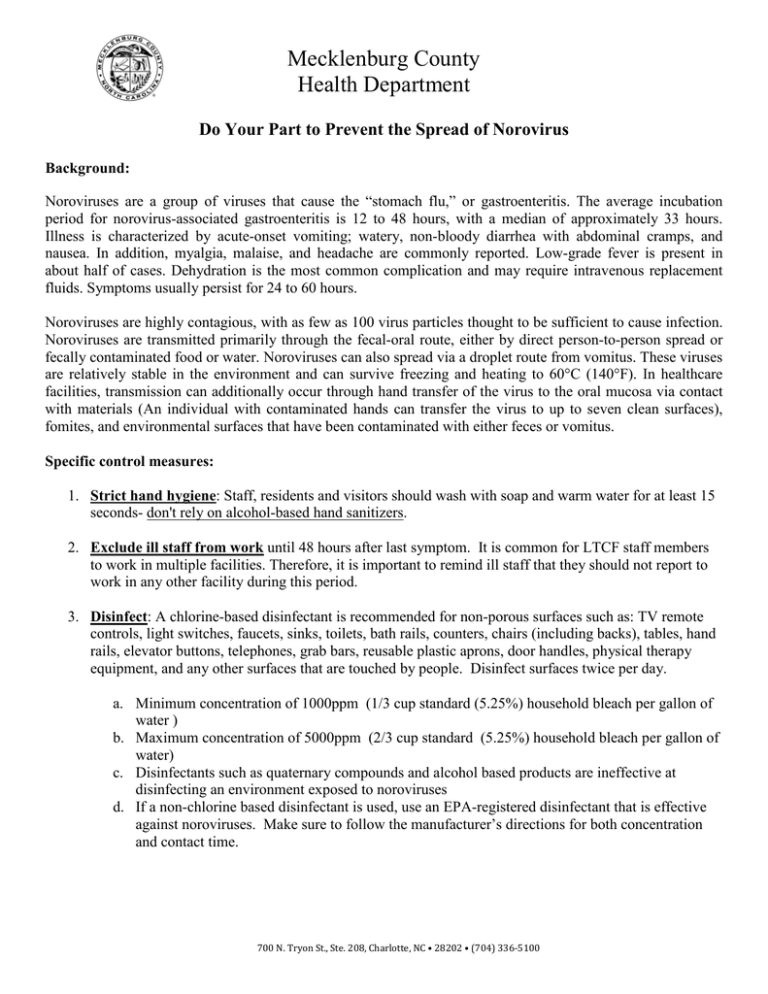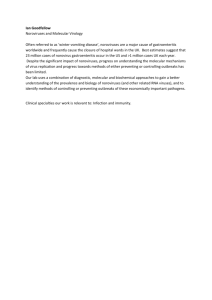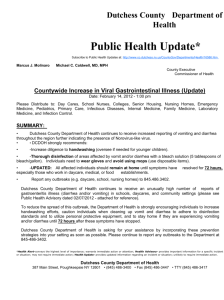Mecklenburg County Health Department
advertisement

Mecklenburg County Health Department Do Your Part to Prevent the Spread of Norovirus Background: Noroviruses are a group of viruses that cause the “stomach flu,” or gastroenteritis. The average incubation period for norovirus-associated gastroenteritis is 12 to 48 hours, with a median of approximately 33 hours. Illness is characterized by acute-onset vomiting; watery, non-bloody diarrhea with abdominal cramps, and nausea. In addition, myalgia, malaise, and headache are commonly reported. Low-grade fever is present in about half of cases. Dehydration is the most common complication and may require intravenous replacement fluids. Symptoms usually persist for 24 to 60 hours. Noroviruses are highly contagious, with as few as 100 virus particles thought to be sufficient to cause infection. Noroviruses are transmitted primarily through the fecal-oral route, either by direct person-to-person spread or fecally contaminated food or water. Noroviruses can also spread via a droplet route from vomitus. These viruses are relatively stable in the environment and can survive freezing and heating to 60°C (140°F). In healthcare facilities, transmission can additionally occur through hand transfer of the virus to the oral mucosa via contact with materials (An individual with contaminated hands can transfer the virus to up to seven clean surfaces), fomites, and environmental surfaces that have been contaminated with either feces or vomitus. Specific control measures: 1. Strict hand hygiene: Staff, residents and visitors should wash with soap and warm water for at least 15 seconds- don't rely on alcohol-based hand sanitizers. 2. Exclude ill staff from work until 48 hours after last symptom. It is common for LTCF staff members to work in multiple facilities. Therefore, it is important to remind ill staff that they should not report to work in any other facility during this period. 3. Disinfect: A chlorine-based disinfectant is recommended for non-porous surfaces such as: TV remote controls, light switches, faucets, sinks, toilets, bath rails, counters, chairs (including backs), tables, hand rails, elevator buttons, telephones, grab bars, reusable plastic aprons, door handles, physical therapy equipment, and any other surfaces that are touched by people. Disinfect surfaces twice per day. a. Minimum concentration of 1000ppm (1/3 cup standard (5.25%) household bleach per gallon of water ) b. Maximum concentration of 5000ppm (2/3 cup standard (5.25%) household bleach per gallon of water) c. Disinfectants such as quaternary compounds and alcohol based products are ineffective at disinfecting an environment exposed to noroviruses d. If a non-chlorine based disinfectant is used, use an EPA-registered disinfectant that is effective against noroviruses. Make sure to follow the manufacturer’s directions for both concentration and contact time. 700 N. Tryon St., Ste. 208, Charlotte, NC • 28202 • (704) 336-5100 4. Detailed cleaning methods: a. Wear gloves and change them between rooms. Wash your hands after removing gloves. b. Clean surface with a disposable towel and soapy water, spray surface with the disinfectant until glistening wet, allow surface to air dry, place used disposable towel in a covered/non-public container c. Do not use the same cleaning cloths on more than one surface d. Clean the laundry from an infected room separately from other laundry e. Do not vacuum in areas where people have vomited on the carpet, as vacuuming spreads the virus into the air. Instead, use a steam cleaner in these areas f. Dispose of single-use drinking cups after each use, and make sure reusable glasses are thoroughly washed, rinsed, sanitized, and allowed to air dry, after each use. Verify that your dish washing machine is sanitizing each load of dishes. 5. Staff Protection: a. When cleaning up contaminated areas, be extra careful to protect yourself from illness by: i. Wearing protective gear during the clean-up, such as boot covers, gloves, a mask, and eye protection ii. Removing and laundering any clothes worn during the clean up iii. Washing hands frequently 6. Resident Protection: a. Restrict ill patients to private rooms when possible. Observe contact isolation precautions b. If someone vomited in a public restroom or other public area, treat the area as contaminated. Close off the area to restrict access and then clean c. Restrict admissions and transfers until outbreak is over (i.e., no new cases for at least 48 hours) d. Post notice for visitors: Consider restricting visitors to a single entry point, and monitor compliance with contact isolation precautions e. Consider canceling group activities until 48 hours after last case Additional Questions? Mecklenburg County Environmental Health: 704-336-5100 Mecklenburg County Communicable Disease Control: 704-336-6438 N.C. Statewide Program for Infection Control and Epidemiology (NC SPICE): http://www.unc.edu/depts/spice/gastroenteritis.doc Laboratory Testing: Specific guidance for specimen collection and shipping: http://slph.state.nc.us 4/11/13 700 N. Tryon St., Ste. 208, Charlotte, NC • 28202 • (704) 336-5100


